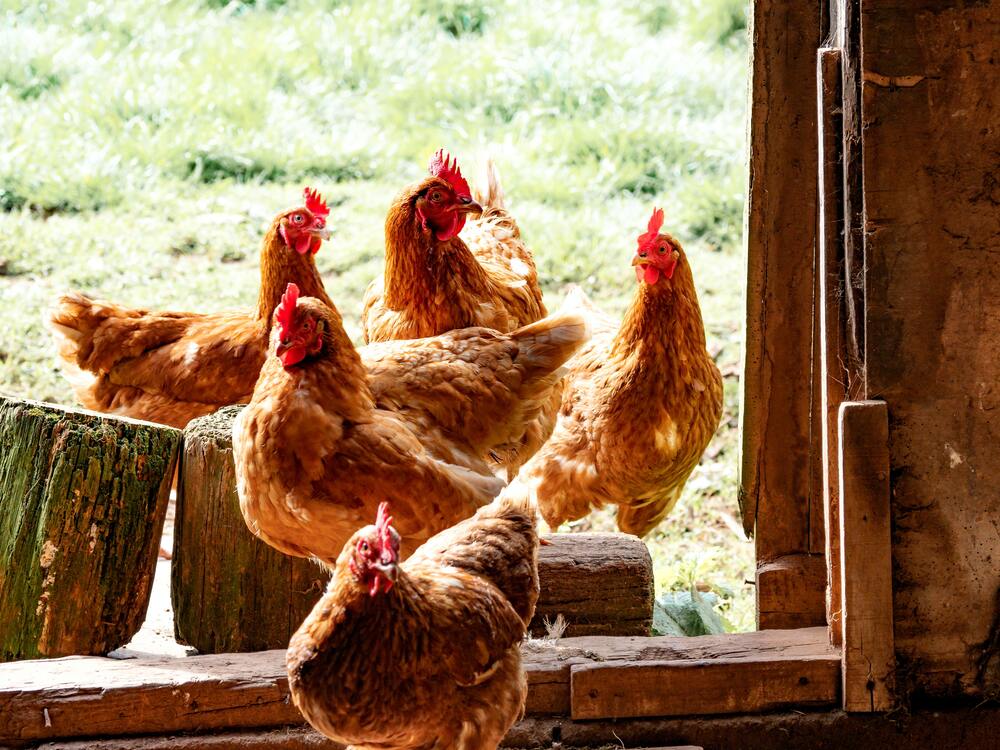Eggs are food commodities that are in great demand by the public, such as chicken, beef, and milk.
The affordable price, adequate nutritional content, and the ability to be processed into a variety of foods make the existence of eggs timeless.
You can use the large need for eggs as a laying hens business idea!
What do you need to prepare to start this business?
Check out the full description here. Starting from the reasons why you should choose this business, tips for success, and estimated capital and profit calculations, all of which are detailed in the following article.
1. Why Laying Chicken Business?
Laying hens are female chickens that are deliberately cultivated for their eggs only. So, why the laying hens business can be categorized as a promising business idea?
Here are some reasons that you can use as a reference for choosing a layer chicken business.
-
Chicken eggs are animal food commodities that are consumed by many people
-
Even though the price of chicken eggs fluctuates, it is still affordable
-
Contains almost all the nutrients needed by the body. Namely 41 nutritional content ranging from vitamin A, vitamin B2, niacin, thiamine, riboflavin, vitamin E, and vitamin D. Only vitamin C is missing.
-
The need for eggs is so high that they are easily found in supermarkets, convenience stores, grocery stores, grocery stores, markets, and online stores.
-
Selling eggs is not difficult. Can be done with various marketing methods. For example, partnering with culinary business owners such as restaurants, cafes, egg suppliers for mini markets, and grocery stores, or selling them directly through the pre-order system and online.
1.1. Nutritional Content of Eggs
Quoted from the Ministry of Trade regarding Raised Chicken Eggs, chicken eggs are rich in nutrients. The nutritional content contained in it, among others, is clearly illustrated in the table below.
| Content | Fresh Chicken Eggs | ||
| Whole | Egg yolk | Egg whites | |
| Calories (cal) | 143 | 322 | 52 |
| Protein (grams) | 12,56 | 15,86 | 10,90 |
| Fat (grams) | 9,51 | 26,54 | 0,17 |
| Carbohydrates (grams) | 0,72 | 3,59 | 0,73 |
| Phosphorus (mg) | 198 | 390 | 15 |
| Vitamin A (IU) | 540 | 1442 | 0 |
1.2. The City With the Most Egg Consumption
Based on a survey taken by the Central Statistics Agency (BPS). The area with the highest egg consumption is on the island of Java, which is dominated by West Java.

Image Source: Badan Pusat Statistik Indonesia
The same data also shows that the largest consumption of chicken eggs per capita per month is in the Riau Islands (0.822 kg/month), West Kalimantan (0.726 kg/month), Riau (0.734 kg/month), and Bangka Belitung (0.666 kg/month). ).
Meanwhile, the smallest per capita consumption per month was found in East Nusa Tenggara (0.141 kg/month), North Maluku (0.167 kg/month), Maluku (0.193 kg/month) and West Sulawesi (0.213 kg/month). The population of DKI Jakarta consumes 0.649 kg/month, West Java consumes 0.564 kg/month and Papua consumes 0.293 kg/month.
2. Types of Layers
Laying hens are divided into two types. White laying hens and brown laying hens. Both are ideal for breeding and are capable of producing quality eggs if cared for as well as possible.
The characteristics of both are as follows.
2.1. White Laying Chicken
This type of chicken is also known as light chicken. Has characteristics, among others:
-
The eggs produced are white
-
Sensitive to hot air and noise
-
When compared to brown laying hens, the body of white laying hens is lighter
-
Easy to find in the market
-
Able to lay more than 260 eggs per year in hen house production
-
Produces eggs at the age of 15 to 16 weeks
2.2. Chocolate Laying Chicken
Often known as medium chicken or dual-purpose chicken because in addition to producing eggs, this chicken can also be used for meat. Has characteristics, among others:
-
The eggs produced are brown
-
The price of eggs is relatively expensive because they are heavier than ordinary eggs
-
Eggs are bigger and rounder than white laying hens
-
Can be used as a broiler
-
Rarely found in the market and if there is the price is expensive
-
Starts laying eggs between 22 to 24 weeks
3. Types of Eggs Produced by Laying Hens
Quoted to the Ministry of Trade (Kemendag), laying hens produce 2 types of chicken eggs. Namely sterile chicken eggs and fertile chicken eggs.
Sterile chicken eggs are obtained from laying hens without going through the fertilization process by the rooster. As for fertile chicken eggs, the eggs are obtained from the fertilization process of a rooster.
The variants of laying hens, among others, are as below.
1. Inorganic eggs
Produced from laying hens fed animal feed. Most of the chicken eggs circulating in the Indonesian market are of this type.
2. Organic eggs
Produced from laying hens that are fed with natural ingredients and without being mixed with artificial feeds or added hormones.
3. Eggs with Omega-3
Are eggs that contain DHA, derived from laying hens that are fed a certain diet so that the content of the eggs produced contains Omega-3. Generally, the feed is mixed with fish oil or other supplements that can increase the DHA content of the eggs.
4. Village chicken eggs
Is a type of egg produced by domestic chickens. Generally, laying hens are given almost the same feed and care as laying hens.
4. Laying Chicken Business Success Tips
If cultivated properly, the laying hens business can be a promising source of income. What are the ways you need to do it? Follow these 7 success tips.
4.1. Choosing the Right Cage Location
Laying hens tend to be easily stressed and have a quite pungent smell of feces.
To deal with these two things, choose a location far from residential areas and avoid loud noises that can stress the chickens quickly.
4.2. Choose Quality Laying Chicken Seeds
Good eggs come from superior chickens. With these superior chicken seeds, you can produce quality eggs and earn more profit.
There are 2 ways you can do to get quality laying hens. Among other things, by incubating laying hens or by buying ready-to-harvest chickens directly from distributors.
Things you must pay attention to when you want to choose to lay hens:
1. Chicken feathers on superior seeds are smooth and shiny
2. ideal chicken body
3. Chicken seeds come from a healthy and quality hen
4. Chicken seeds must be healthy
5. Chicken seeds have a high appetite
6. There are no defects in the body of the chicken seeds
4.3. Suitable Chicken Feed
Quality chicken eggs are obtained from superior and healthy chicken seeds. Therefore, it is important that you choose good chicken feed.
During the feeding process, there are at least 2 phases that you need to do. The first is the starter phase where feed is given in the initial four weeks. The second is the finishing phase in the fifth to the sixth week.
Types of feed that you can choose include:
-
Corn
-
Center
-
Fish flour
-
Soybean Meal
The four feeds are rich in nutrients and protein needed by laying hens. For the composition of chicken feed, you can mix 47.14% corn and 10 – 25% soybean meal.
And the quantity required for laying hens ranges from 2.18 to 2.25 kg. From the amount of feed, the estimated eggs you will get range from 1 kg of eggs.
In addition, to feeding, another intake that you should pay attention to is the provision of anti-stress drugs dissolved in drinking water and a little sugar so that the taste is not bitter. This is done to keep the existing chickens from being stressed because if stress hits, the chickens cannot produce quality eggs and have the potential to fail.
4.4. Keeping the Cage Clean
Cleanliness of the cage may be the spearhead of the success or failure of the laying hens business. Because a clean cage will have a good impact on the health of the existing chickens.
Chickens that are healthy and always stress-free will produce good quality eggs and your business can run smoothly.
Another case is if you do not pay attention to the cleanliness of the cage. The existing chickens will be easily stressed, get sick quickly, and lead to losses.
Tips for keeping the cage clean:
1. Clean the chicken coop every day
2. Build a chicken coop above the pond so that the dirt can fall to the bottom and is easy to clean
4.5. Vaccination of laying hens
To maintain egg quality in order to stay prime, laying hens that you have must be vaccinated.
This vaccine is given as additional nutrition and vitamins to maintain the health of laying hens.
Additional tips: Do not mix sick chickens with other chickens. This is because sick chickens will more easily spread the disease to other chickens.
If there are sick chickens, try to separate them and provide intensive care.
4.6. Pay Attention to the Harvest Process
Harvesting chicken eggs can be done 2-3 times a day. Usually can be done in the morning, afternoon, and evening.
Even so, you should still do quality control on the eggs that are there. So that later sales can be maximized.
How to determine quality eggs and not:
-
Quality eggs are generally oval in shape, not oval let alone flat
-
Eggs of poor quality tend to have a very small size
-
Eggs with thin shells
-
Eggs of poor quality will float on the water, which means the contents of the eggs are rotten
-
Quality eggs will sink into the water
5. Doing Cooperation or Business Partners
The next important tip is to collaborate or partner in business to sell your egg harvest.
For example, you can sell eggs to people's homes near you, middlemen, grocery stores, food establishments, distributors or agents, and many more.

Image Source: Unsplash/Erol Ahmed
6. Estimated Capital and Profits from the Laying Chicken Business
Quoted from the GDM website, the following is an estimate of the capital you must prepare if you want to start a breeder chicken business.
| Details of Laying Chicken Business Capital | ||||||
| Equipment Needs Initial Fund | ||||||
| No. | Description | Unit | Total | Unit Price | Total | |
| 1. | Cage for 100 Laying Chickens | Package | IDR 3.850.000 | |||
| 2. | Feed Gutter | cm | Approximately 80pcs Feed Gutters | IDR 89.000 | IDR 89.000 | |
| 3. | Nipple/Cattle Drinking Container | pcs | 50 | IDR 7.000 | IDR 35.000 | |
| 4. | Egg Place | cs | 200 | IDR 5.000 | IDR 1.000.000 | |
| 5. | Land lease | M2 | 20 | IDR 13.000 | IDR 260.000 | |
| 6. | Scales | unit | 1 | IDR 200.000 | IDR 200.000 | |
| 7. | Bucket | unit | 2 | IDR 10.000 | IDR 20.000 | |
| 8. | Shovel | unit | 1 | IDR 35.000 | IDR 35.000 | |
| Total | IDR 5.489.00 | |||||
| Equipment Depreciation Fund | ||||||
| No. | Description | Unit | Total | Unit Price | Total | |
| 1. | Cage for 100 Laying Chickens | Paket | 1/24 x IDR 3.850.000 | IDR 160.500 | ||
| 2. | Feed Gutter | cm | Approximately 80pcs Feed Gutters | 1/24 x IDR 89.000 | IDR 3.700 | |
| 3. | Nipple/Cattle Drinking Container | pcs | 50 | 50/24 X IDR 35.000 | IDR 72.900 | |
| 4. | Egg Place | cs | 200 | 833/24 x IDR 1.000.000 | IDR 8.300 | |
| 5. | Land lease | M2 | 20 | 1/24 x IDR 260.000 | IDR 10.800 | |
| 6. | Scales | unit | 1 | 1/24 x IDR 200.000 | IDR 8.300 | |
| 7. | Bucket | unit | 2 | 2/24 x IDR 20.000 | IDR 1.700 | |
| 8. | Shovel | unit | 1 | 1/24 x IDR 35.000 | IDR 1.500 | |
| Total | IDR 267.700 | |||||
| Operating costs | ||||||
| No. | Description | Unit | Total | Unit Price | Total | |
| 1. | Laying hens aged 16 weeks | Tail | 100 | IDR 52.000 | IDR 5.200.000 | |
| 2. | Feed | KG | 360 KG/Month | IDR 6.000 | IDR 2.160.000 | |
| 3. | Vaccine | Package | IDR 833.000 | IDR 833.000 | ||
| 4. | Liquid Organic Supplements | Liter | 1 liter/Month | IDR 26.000 | IDR 26.000 | |
| 5. | Electricity | Package | IDR 833.000 | IDR 833.000 | ||
| 6. | Water | Package | IDR 550.000 | IDR 550.000 | ||
| 7. | Cage Builder Salary | IDR | IDR 750.000 | IDR 750.000 | ||
| Total | IDR 9.869.000 | |||||
| Total Cost Required For 100 Laying Chicken Business | IDR 10.136.700 | |||||
The details of the profits of the laying hens business are listed in the table below.
| Details of the Profits of Laying Chicken Business | |||||
| Monthly Income | |||||
| No. | Description | Unit | Total | Unit price | Total |
| 1. | Egg | Item | 6 KG/Month | IDR 13.000 | IDR 2.340.000 |
| 2. | rejected chicken | Tail | 5 Ekor/Month | IDR 25.000 | IDR 125.000 |
| 3. | Chicken manure | Sack | 150 Sacks/Month | IDR 5.000 | IDR 750.000 |
| Total Income per Month | IDR 3,215,000 | ||||
|
Total Profit of Laying Chicken Business for One Period (Monthly Income x 24 Months - Capital) |
IDR 77,160,000 – IDR 10,136,700 = IDR 67,023,300 | ||||
From the table above, it can be concluded that in one period or for 24 months, you will earn a profit of IDR 67,023,300. Very tempting isn't it?
The figures listed in the table are estimates only, for unit prices of goods and other necessities follow the latest current prices. The profit you get can be even greater if the number of existing livestock is increased.
7. How to Get Laying Chicken Business Capital
Interested in pursuing the laying hens business? Just apply for a loan at BFI Finance!
The process is safe, easy, and has been verified by OJK (Financial Services Authority). You can apply for a loan for a laying hens business with an adjustable choice of collateral. Are as follows.
Disbursement of funds up to 85% of the value of the vehicle and a tenor of up to 3 years.
Loan funds with a fast process and a maximum tenor of up to 18 months.
Low interest starts from 0.9% with a long tenor of up to 48 months.
Sobat BFI, That's the discussion of Laying Chicken Business Ideas: Tips for Success, Estimated Capital, and Profits. Hopefully, this article can be an inspiration for your business idea. Do not be afraid to try. Greetings!
Check articles and other interesting information at BFI Blog.






